Abstract
Two monoclonal mouse antibodies with specificities for group B streptococcal capsular antigens were evaluated in assays for the identification of group B streptococci (GBS). One of these antibodies (A9) was shown to precipitate group B carbohydrate antigen in reactions with both purified group B antigen and antigen present in autoclave or enzyme extracts of GBS. A9 antibody was also specific for group B antigen in gel diffusion reactions with extracts of Lancefield group A, B, C, D, F, and G streptococci and was a highly sensitive reagent in detecting soluble group B antigen by counterimmunoelectrophoresis. Antigen extracted from all five serotypes of GBS was shown to be precipitated by A9 antibody. A second monoclonal antibody (C8) was reactive with intact GBS but did not precipitate soluble antigen in bacterial extracts. In contrast with what has been shown for polyclonal rabbit anti-group B antiserum, neither antibody was significantly inhibited in binding or precipitation assays by high concentrations of free rhamnose or other monosaccharides of carbohydrates found in group B antigen. Rhamnose, the most abundant carbohydrate of the group B antigen, does not appear therefore to be an immunodominant determinant in the binding of A9 or C8 antibody. The epitopes of both monoclonal antibodies are exposed on the surface of live as well as heat-fixed GBS cells. A9 antibody-coated latex particles were compared with a commercially available polyclonal latex agglutination reagent and shown to be equally sensitive and specific in the detection of soluble group B antigen in urine and cerebrospinal fluid from patients with GBS infections. Because of its uniformity and defined antigen specificity, which includes reactivity with all five serotypes of GBS, A9 antibody offers the potential of an improved immunodiagnostic reagent for the identification of GBS.
Full text
PDF

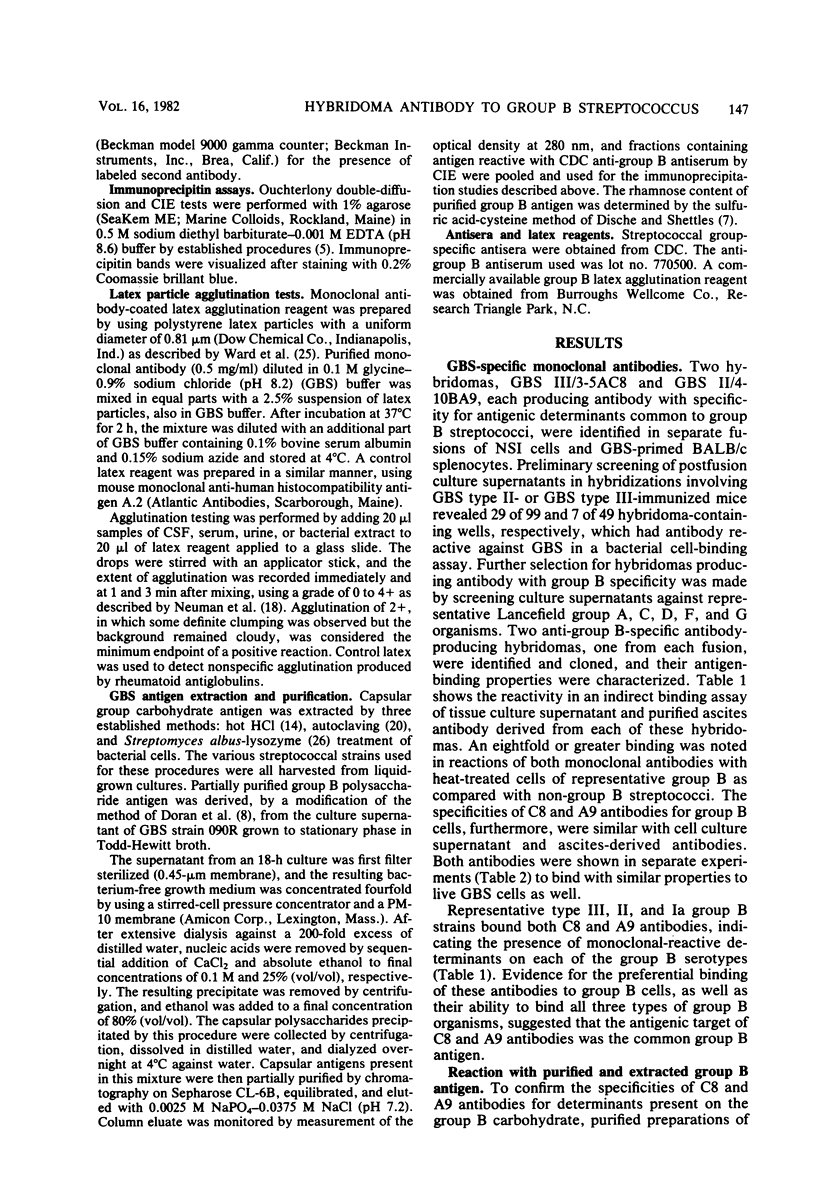

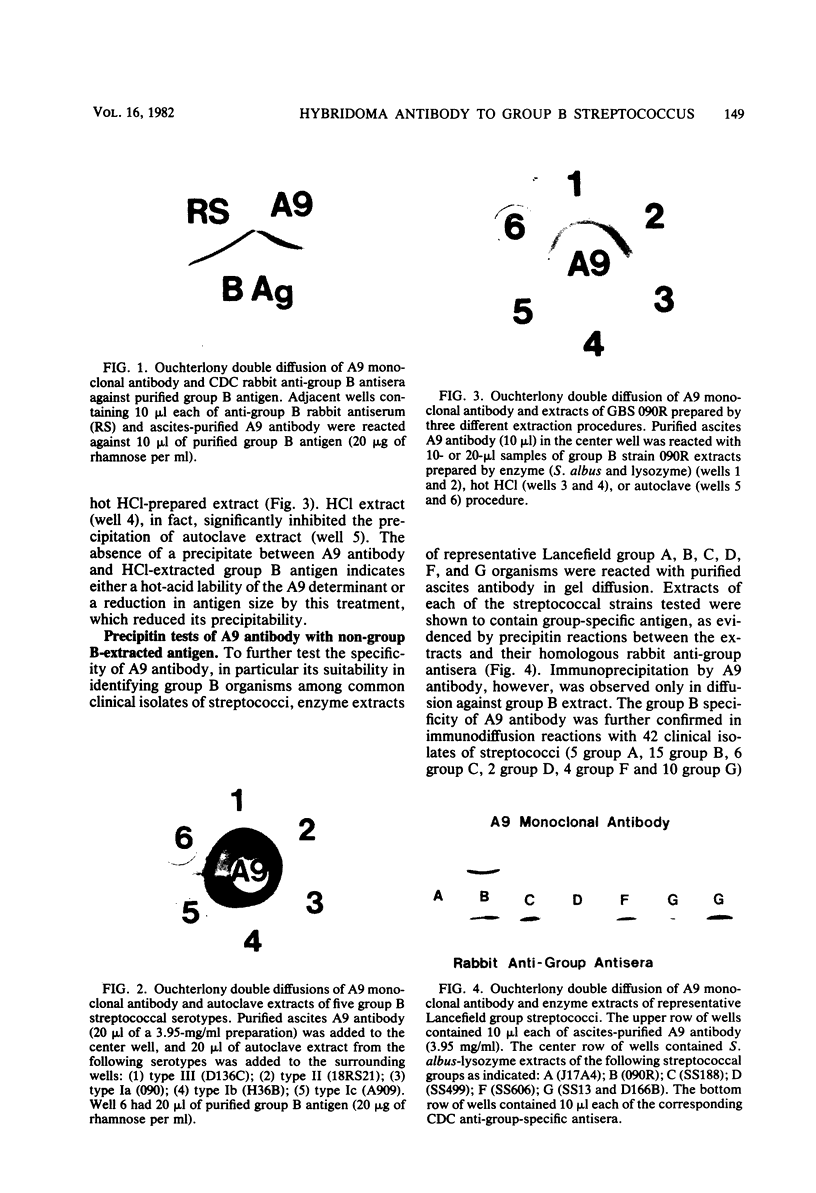
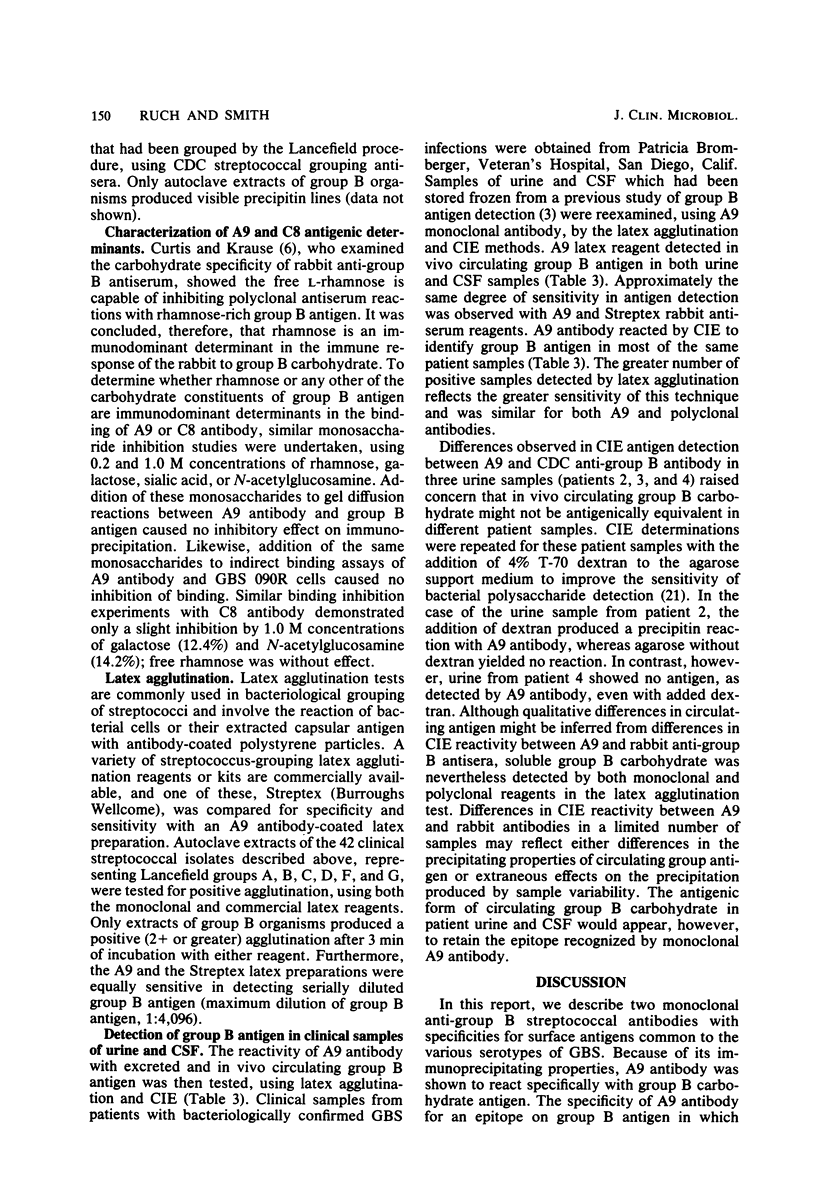
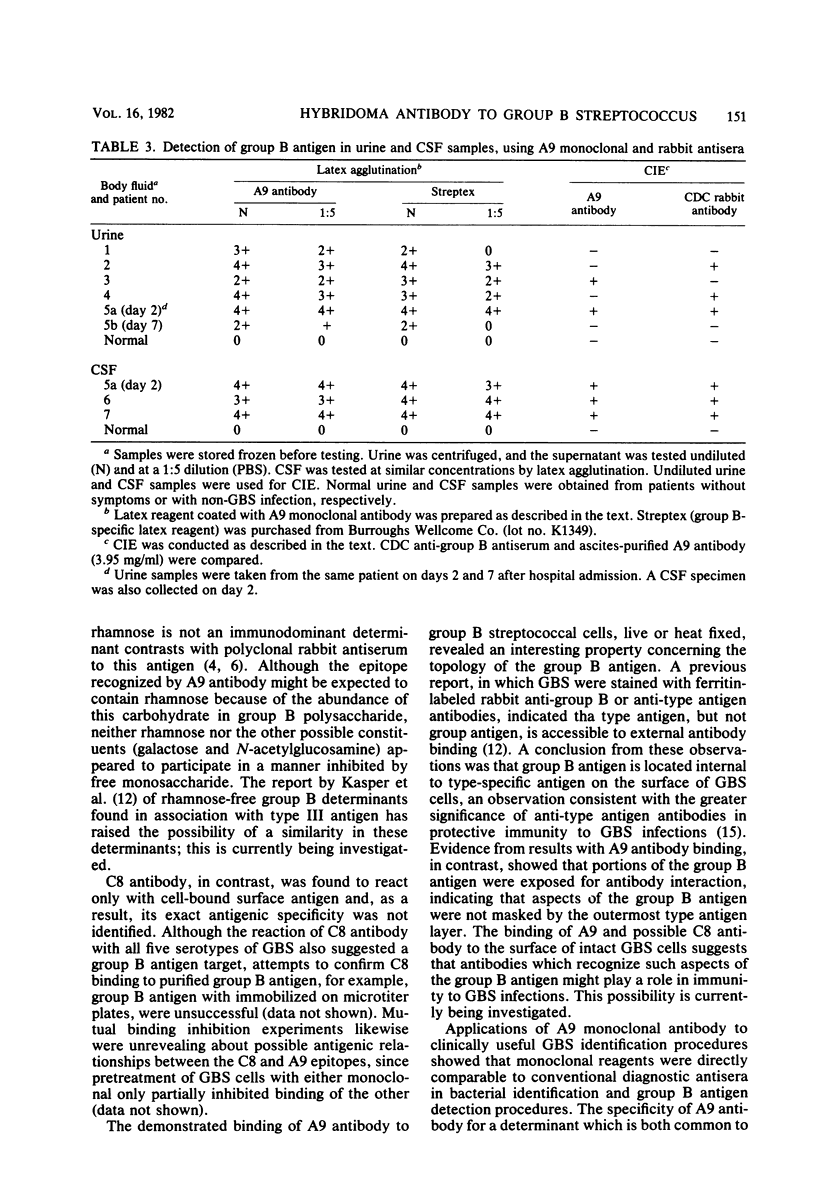
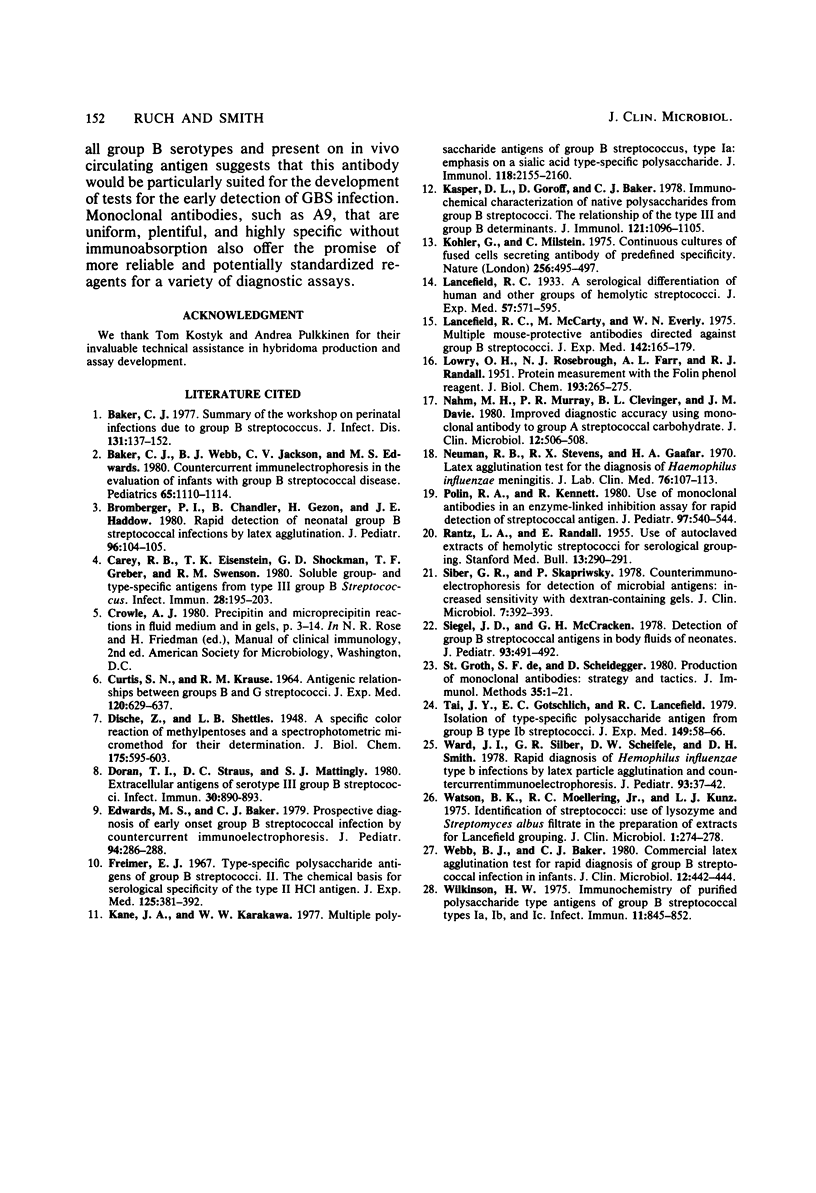
Images in this article
Selected References
These references are in PubMed. This may not be the complete list of references from this article.
- Baker C. J., Webb B. J., Jackson C. V., Edwards M. S. Countercurrent immunoelectrophoresis in the evaluation of infants with group B streptococcal disease. Pediatrics. 1980 Jun;65(6):1110–1114. [PubMed] [Google Scholar]
- Bromberger P. I., Chandler B., Gezon H., Haddow J. E. Rapid detection of neonatal group B streptococcal infections by latex agglutination. J Pediatr. 1980 Jan;96(1):104–106. doi: 10.1016/s0022-3476(80)80340-4. [DOI] [PubMed] [Google Scholar]
- CURTIS S. N., KRAUSE R. M. ANTIGENIC RELATIONSHIPS BETWEEN GROUPS B AND G STREPTOCOCCI. J Exp Med. 1964 Oct 1;120:629–637. doi: 10.1084/jem.120.4.629. [DOI] [PMC free article] [PubMed] [Google Scholar]
- Carey R. B., Eisenstein T. K., Shockman G. D., Greber T. F., Swenson R. M. Soluble group- and type-specific antigens from type III group B Streptococcus. Infect Immun. 1980 Apr;28(1):195–203. doi: 10.1128/iai.28.1.195-203.1980. [DOI] [PMC free article] [PubMed] [Google Scholar]
- Doran T. I., Straus D. C., Mattingly S. J. Extracellular antigens of serotype III group B streptococci. Infect Immun. 1980 Dec;30(3):890–893. doi: 10.1128/iai.30.3.890-893.1980. [DOI] [PMC free article] [PubMed] [Google Scholar]
- Edwards M. S., Baker C. J. Prospective diagnosis of early onset group B streptococcal infection by countercurrent immunoelectrophoresis. J Pediatr. 1979 Feb;94(2):286–288. doi: 10.1016/s0022-3476(79)80845-8. [DOI] [PubMed] [Google Scholar]
- Freimer E. H. Type-specific polysaccharide antigens of group B streptococci. II. The chemical basis for serological specificity of the type II HCl antigen. J Exp Med. 1967 Mar 1;125(3):381–392. doi: 10.1084/jem.125.3.381. [DOI] [PMC free article] [PubMed] [Google Scholar]
- Kane J. A., Karakawa W. W. Multiple polysaccharide antigens of group B streptococcus, type Ia: emphasis on a sialic acid type-specific polysaccharide. J Immunol. 1977 Jun;118(6):2155–2160. [PubMed] [Google Scholar]
- Kasper D. L., Goroff D. K., Baker C. J. Immunochemical characterization of native polysaccharides from group B streptococcus: the relationship of the type III and group B determinants. J Immunol. 1978 Sep;121(3):1096–1105. [PubMed] [Google Scholar]
- Köhler G., Milstein C. Continuous cultures of fused cells secreting antibody of predefined specificity. Nature. 1975 Aug 7;256(5517):495–497. doi: 10.1038/256495a0. [DOI] [PubMed] [Google Scholar]
- LOWRY O. H., ROSEBROUGH N. J., FARR A. L., RANDALL R. J. Protein measurement with the Folin phenol reagent. J Biol Chem. 1951 Nov;193(1):265–275. [PubMed] [Google Scholar]
- Lancefield R. C., McCarty M., Everly W. N. Multiple mouse-protective antibodies directed against group B streptococci. Special reference to antibodies effective against protein antigens. J Exp Med. 1975 Jul 1;142(1):165–179. doi: 10.1084/jem.142.1.165. [DOI] [PMC free article] [PubMed] [Google Scholar]
- Nahm M. H., Murray P. R., Clevinger B. L., Davie J. M. Improved diagnostic accuracy using monoclonal antibody group A streptococcal carbohydrate. J Clin Microbiol. 1980 Oct;12(4):506–508. doi: 10.1128/jcm.12.4.506-508.1980. [DOI] [PMC free article] [PubMed] [Google Scholar]
- Newman R. B., Stevens R. W., Gaafar H. A. Latex agglutination test for the diagnosis of Haemophilus influenzae meningitis. J Lab Clin Med. 1970 Jul;76(1):107–113. [PubMed] [Google Scholar]
- Polin R. A., Kennett R. Use of monoclonal antibodies in an enzyme-linked inhibition assay for rapid detection of streptococcal antigen. J Pediatr. 1980 Oct;97(4):540–544. doi: 10.1016/s0022-3476(80)80005-9. [DOI] [PubMed] [Google Scholar]
- RANTZ L. A., RANDALL E. Use of autoclaved extracts of hemolytic streptococci for serological grouping. Stanford Med Bull. 1955 May;13(2):290–291. [PubMed] [Google Scholar]
- Siber G. R., Skapriwsky P. Counterimmunoelectrophoresis for detection of microbial antigens: increased sensitivity with dextran-containing gels. J Clin Microbiol. 1978 Apr;7(4):392–393. doi: 10.1128/jcm.7.4.392-393.1978. [DOI] [PMC free article] [PubMed] [Google Scholar]
- Siegel J. D., McCracken G. H., Jr Detection of group B streptococcal antigens in body fluids of neonates. J Pediatr. 1978 Sep;93(3):491–492. doi: 10.1016/s0022-3476(78)81174-3. [DOI] [PubMed] [Google Scholar]
- Tai J. Y., Gotschlich E. C., Lancefield R. C. Isolation of type-specific polysaccharide antigen from group B type Ib streptococci. J Exp Med. 1979 Jan 1;149(1):58–66. doi: 10.1084/jem.149.1.58. [DOI] [PMC free article] [PubMed] [Google Scholar]
- Ward J. I., Siber G. R., Scheifele D. W., Smith D. H. Rapid diagnosis of Hemophilus influenzae type b infections by latex particle agglutination and counterimmunoelectrophoresis. J Pediatr. 1978 Jul;93(1):37–42. doi: 10.1016/s0022-3476(78)80596-4. [DOI] [PubMed] [Google Scholar]
- Watson B. K., Moellering R. C., Jr, Kunz L. J. Identification of streptococci: use of lysozyme and Streptomyces albus filtrate in the preparation of extracts for Lancefield grouping. J Clin Microbiol. 1975 Mar;1(3):274–278. doi: 10.1128/jcm.1.3.274-278.1975. [DOI] [PMC free article] [PubMed] [Google Scholar]
- Webb B. J., Baker C. J. Commercial latex agglutination test for rapid diagnosis of group B streptococcal infection in infants. J Clin Microbiol. 1980 Sep;12(3):442–444. doi: 10.1128/jcm.12.3.442-444.1980. [DOI] [PMC free article] [PubMed] [Google Scholar]
- Wilkinson H. W. Immunochemistry of purified polysaccharide type antigens of group B streptococcal types Ia, Ib, and Ic. Infect Immun. 1975 Apr;11(4):845–852. doi: 10.1128/iai.11.4.845-852.1975. [DOI] [PMC free article] [PubMed] [Google Scholar]
- de StGroth S. F., Scheidegger D. Production of monoclonal antibodies: strategy and tactics. J Immunol Methods. 1980;35(1-2):1–21. doi: 10.1016/0022-1759(80)90146-5. [DOI] [PubMed] [Google Scholar]






